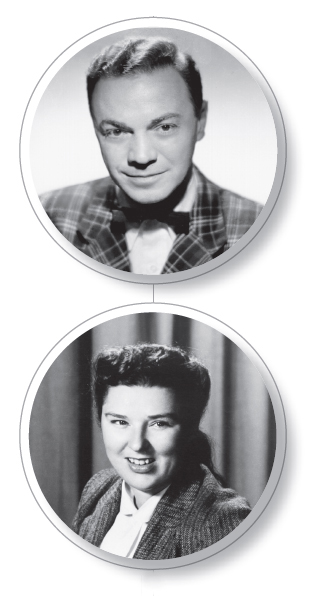Exploring American Histories: Printed Page 789
Exploring American Histories, Value Edition: Printed Page 644
American Histories: Alan Freed and Grace Metalious
AMERICAN HISTORIES

Alan Freed shook up American youth culture in the 1950s by rebranding existing black music and making it popular with white teenagers. Rock ’n’ roll was a slang term among African Americans for sexual intercourse, but Freed turned it into an expression of musical rebellion. In 1951, at the age of twenty-nine, Aldon (Alan) James Freed was spinning records as a disc jockey, or “deejay,” at a Cleveland, Ohio, radio station. He started out playing classical music but switched to rhythm and blues, an African American music style considered “race music.” Freed began calling himself Moondog, howling like a dog, and using sound effects to rattle his radio listeners. Although he initially appealed mainly to a black audience, Freed’s radio show and live concerts of music he dubbed rock ’n’ roll soon attracted white teenagers.
In 1954 Freed moved to New York City radio station WINS, where his evening rock ’n’ roll broadcast became a number one hit. Three years later at the height of his popularity, he hosted a nationally televised rock ’n’ roll program, but only briefly. The American Broadcasting Company canceled Freed’s show after four telecasts because of outrage from affiliate stations in the South after the black singer Frankie Lymon was shown dancing with a white girl.
The television incident was only the start of Freed’s professional problems. In 1960 Freed was brought before a congressional committee investigating “payola,” a common practice among deejays of receiving gifts from record companies in exchange for playing their records. His career sank further when Freed was indicted in 1962 for commercial bribery by New York State. He was found guilty, was fined $300, and received a six-month suspended jail sentence. Freed never regained his earlier stature. Impoverished and struggling with alcoholism, Freed died in 1965 at the age of forty-three.
Like Alan Freed, Grace Metalious sent shock waves through American popular culture in the 1950s. Metalious grew up in poverty in a small mill town in southern New Hampshire. In 1943, while still a teenager, she married George Metalious and became a mother and housewife. In 1956 Metalious published her first novel, Peyton Place. Based on her hometown, the book sold more than three million copies the first year and unsettled the literary world. Considered provocative and racy because of its discussion of sex, rape, and incest, the novel punctured myths about the straitlaced life of small-town America. It criticized small-minded conformity that enforced a double standard of sexual behavior on women.
Despite the book’s popularity, which inspired a toned-down Hollywood film and a television series, Metalious was never seen as a serious writer. Detractors described her as an untalented author who disseminated filth. In response to such allegations, she countered, “If I’m a lousy writer, then an awful lot of people have lousy taste.” Metalious could not reconcile her success with the criticism she received and, like Alan Freed, increasingly turned to alcohol for comfort. She wrote other novels, but they never achieved the success that Peyton Place had. In 1964, a year before Freed’s death and just eight years after publication of Peyton Place, she died at age thirty-nine of cirrhosis of the liver. Both Metalious and Freed challenged notions of conventional taste, and both found their lives upended by the conservative backlash their work inspired. •
IRONICALLY, THE AMERICAN HISTORIES of Alan Freed and Grace Metalious, both of whom attacked conformity, were made possible by the emergence of a mass-consumption economy fueled by technological innovation. The production of inexpensive paperback books enabled Peyton Place to reach a broad market. The development of low-cost records made rock ’n’ roll songs widely available, and the creation of handheld transistor radios allowed teenagers to listen to music—played by deejays like Alan Freed—away from their parents’ supervision. Young people were not the only ones to challenge their parents’ culture. Writers and musicians experimented with freer forms of artistic expression and attacked the conformity they associated with mainstream America. African Americans challenged racial segregation directly in the Supreme Court and through powerful community protests. The Cold War remained the chief feature of foreign affairs and, despite wide-ranging prosperity, continued to generate fears for the safety and security of all Americans.